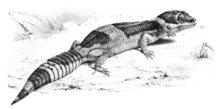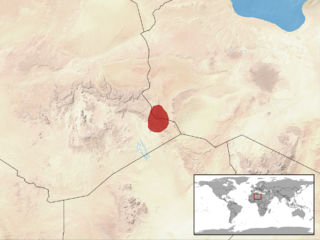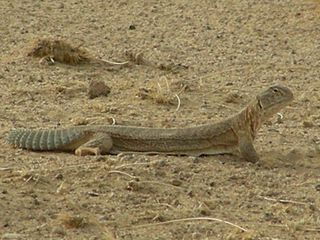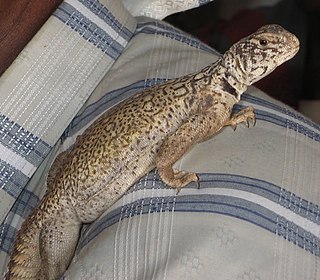
Agamidae is a family of over 550 species of iguanian lizards indigenous to Africa, Asia, Australia, and a few in Southern Europe. Many species are commonly called dragons or dragon lizards.

Uromastyx is a genus of African and Asian lizards in the family Agamidae. Member species are commonly called spiny-tailed lizards, uromastyces, mastigures, or dabb lizards. Lizards in the genus Uromastyx are primarily herbivorous, but occasionally eat insects and other small animals, especially young lizards. They spend most of their waking hours basking in the sun, hiding in underground chambers at daytime or when danger appears. They tend to establish themselves in hilly, rocky areas with good shelter and accessible vegetation.
The spiny weapontail is a species of lizard belonging to the monotypic genus Hoplocercus in the family Hoplocercidae. The species is found in the Cerrado and adjacent Cerrado–Amazon mosaics in Brazil and Bolivia.

Major-General Thomas Hardwicke was an English soldier and naturalist who was in India from 1777 to 1823. He collected numerous specimens of natural history and had them painted by Indian artists. From these paintings many new species were described. Several of these species are named after him. On returning to England he collaborated with the zoologist John Edward Gray to publish Illustrations of Indian Zoology (1830–1835).
Desert National Park is a national park situated in the Indian state of Rajasthan, near the towns of Jaisalmer and Barmer. This is one of the largest national parks, covering an area of 3162 km². The Desert National Park is an excellent example of the ecosystem of the Thar Desert. Sand dunes form around 44% of the Park. The major landform consists of craggy rocks and compact salt lake bottoms, intermedial areas and fixed dunes. The park was gazetted in 1980.

The laggar falcon, also known as the lugger falcon or jugger is a mid-sized bird of prey which occurs in the Indian subcontinent from extreme southeastern Iran, southeastern Afghanistan, Pakistan, through India, Nepal, Bhutan, Bangladesh and northwestern Myanmar.

Hardwicke's bloodsucker is an agamid lizard and found in South Asia.

The East Indian leopard gecko, also known commonly as Hardwicke's gecko, is a species of gecko, a lizard in the family Eublepharidae. The species is endemic to India and Bangladesh.

The spine-bellied sea snake, also commonly known as Hardwicke's sea snake and Hardwicke's spine-bellied sea snake, is a species of venomous sea snake in the family Elapidae. The species is native to the Indian Ocean and the western Pacific Ocean.

Uromastyx geyri is a species of lizard belonging to the family Agamidae. The species is native to North Africa.

Uromastyx alfredschmidti, commonly known as the ebony mastigure, Schmidt's mastigure, or Schmidt's spiny-tailed lizard, is a species of lizard in the family Agamidae. The species is indigenous to North Africa.

The common butterfly lizard, or simply the butterfly lizard, is a widespread species of lizard in the family Agamidae. The species is native to Asia.

Uromastyx aegyptia is a species of lizard in the family Agamidae. The species is endemic to North Africa and the Middle East.

Uromastyx dispar flavifasciata is a subspecies of spiny-tailed lizard belonging to the family Agamidae. It is found in rocky, arid and desert habitats in North Africa, its range including parts of Algeria, Mali and Niger. While sometimes considered a separate species, other treat it as a subspecies of Uromastyx dispar.

Saara is a genus of lizards in the subfamily Uromasticinae of the family Agamidae. The genus is endemic to Asia.

Uromastyx ornata, commonly called the ornate mastigure, is a species of lizard in the family Agamidae.

Saara asmussi, also known commonly as the Iranian mastigure and the Persian spiny-tailed lizard, is a species of lizard belonging to the family Agamidae. The species is endemic to Asia.
Xenagama wilmsi, the Wilms' agama, shield-tail agama, or turnip-tail agama, is a species of lizard in the family Agamidae. The species is endemic to the Horn of Africa.

Uromastyx benti, also known commonly as Bent's mastigure and the Yemeni spiny-tailed lizard, is a species of lizard in the family Agamidae. The species is native to the southeastern Arabian Peninsula.






























